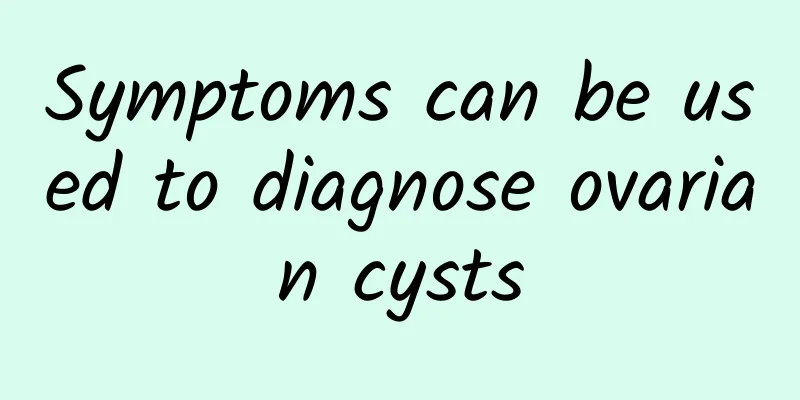Symptoms can be used to diagnose ovarian cysts

|
How to diagnose ovarian cysts is a topic that many female friends are very concerned about. After all, for ovarian cysts, early treatment is more effective. So, can ovarian cysts be diagnosed based on symptoms? In response to this question, let's ask an expert to introduce to you the method of diagnosing ovarian cysts. 1. Diagnosis of ovarian cysts: increased abdominal circumference and intra-abdominal tumors This is the most common phenomenon for patients. Patients feel that their clothes or belts are too tight, and they just notice that their abdomen is enlarged, or they feel it accidentally in the morning, so they press their abdomen and find that there is a mass in the abdomen, plus abdominal distension and discomfort. 2. Abdominal pain If the tumor has no complications, there is very little pain. Therefore, if an ovarian tumor patient feels abdominal pain, especially if it occurs suddenly, the diagnosis of ovarian cysts is mostly due to torsion of the tumor pedicle, or occasionally due to tumor rupture, bleeding or infection. In addition, malignant cysts often cause abdominal pain and leg pain, and the pain often causes patients to seek emergency treatment. 3. Compression symptoms Huge ovarian tumors can cause dyspnea and palpitations due to compression of the diaphragm. Ovarian tumors combined with a large amount of ascites can also cause these symptoms. However, the dyspnea of some ovarian tumor patients is caused by unilateral or bilateral pleural effusion, and is often combined with ascites, forming the so-called Meigs syndrome. 4. Menstrual disorders Generally, ovarian cysts, even bilateral ovarian cysts, do not cause menstrual disorders because they do not destroy all normal ovarian tissues. Some uterine bleeding is not endocrine, or it is caused by ovarian tumors that change the distribution of pelvic blood vessels, causing endometrial congestion; or it is caused by ovarian malignant tumors that directly metastasize to the endometrium. Menstrual disorders caused by endocrine tumors are often combined with other secretory effects. This is one of the methods for diagnosing ovarian cysts. The above is the introduction of symptoms that can be used to diagnose ovarian cysts. It is for reference only. If you really don’t know whether you have ovarian cysts, please choose a regular hospital for diagnosis. In addition, if you have any questions about the diagnosis of ovarian cysts, please consult online experts! For more information, please visit the ovarian cyst disease topic http://www..com.cn/fuke/ncnn/ or consult with experts for free. The experts will give detailed answers based on the patient's specific situation! |
<<: Do you have any of these causes of ovarian cysts?
>>: Choose the best time for abortion to reduce damage
Recommend
What should I do if I have chronic cervicitis during pregnancy? It is recommended to deal with chronic cervicitis during pregnancy
Chronic cervicitis is a common disease. Many preg...
Long-term dietary structure is related to the cause of ovarian cysts
Most ovarian cysts are benign tumors. The causes ...
Pelvic inflammatory disease usually causes pain in three places
Pelvic inflammatory disease is a common inflammat...
Precautions for the treatment of cervical hypertrophy
Cervical hypertrophy has become a common disease ...
Stop before, during and after strenuous exercise! The hidden dangers of energy drinks
If you like to drink a can of energy drink to boo...
Several effective methods for regulating irregular menstruation
In real life, mild menstrual disorders can be cur...
Hyperprolactinemia Specialized Hospital
I believe that everyone knows the harm that hyper...
Does cervicitis affect menstruation?
Whether cervicitis will affect menstruation needs...
What are the hazards of congenital absence of vagina to women?
Congenital absence of vagina is a rare disease in...
What can I eat to eliminate uterine fibroids? What can I eat to eliminate uterine fibroids?
What can I eat to eliminate uterine fibroids? Wha...
Red dates are not only good for beauty, they also have 6 great benefits! Nutritionists teach healthy cooking, men and women are different
There is a saying that "eat red dates every ...
Eating ice can cause edema-type obesity, which is actually caused by spleen upset! Chinese medicine practitioner Dong Yirong: Codonopsis and red dates tea nourishes the spleen and reduces fat
As the weather gets hotter, the market for variou...
Subserosal uterine fibroids treatment method Can subserosal uterine fibroids be treated with surgery?
If a woman suffers from subserosal uterine fibroi...
What are the good treatments for chronic adnexitis?
Women are very familiar with adnexitis. There are...
Can hyperprolactinemia be cured?
If you suffer from hyperprolactinemia, this disea...









